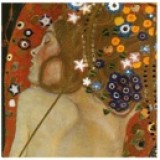Daily Sip - Strange Fruit
-
sibyllene
12 years agoWell, so it's not daily. But it's for today. A bit of a somber poem by Seamus Heaney. It is considered his last "bog poem." I feel like I have a fairly good idea about what it's about (on the surface), but want to see if others agree. I -think- this poem was published in either 1969's "Door into the Dark," or 1975's "North," but I haven't been able to find out for sure. I'll keep looking.
------------------
Strange Fruit
Here is the girl's head like an exhumed gourd.
Oval-faced, prune-skinned, prune-stones for teeth.
They unswaddled the wet fern of her hair
And made an exhibition of its coil,
Let the air at her leathery beauty.
Pash of tallow, perishable treasure:
Her broken nose is dark as a turf clod,
Her eyeholes blank as pools in the old workings.
Diodorus Siculus confessed
His gradual ease with the likes of this:
Murdered, forgotten, nameless, terrible
Beheaded girl, outstaring axe
And beatification, outstaring
What had begun to feel like reverence. -
Yakari Gabriel
12 years agoWould you care to enlighten me?
I mean..
but this time
I'm as clueless as....
shoot, couldn't think of a good comparison.. dem it.
no? yes? no?
no. -
silvershoes
12 years agoNot sure.
I can't think of Strange Fruit without thinking of Billie Holiday and lynchings. -
sibyllene
12 years agoThat was my first thought too, Jane. I keep hearing the song.
But regarding this poem, my first thought was that it was about the mummified people that have been found in Ireland's bogs. This is pretty accurate, but the deeper meaning of the poem (according to what I read) has to do with using the mummified girl as a symbol for the victims of Ireland's politically and religiously-driven Troubles.
This article has some interesting background and analysis about how Heaney used the "bog" theme to describe Ireland's physical AND cultural landscape:
"Landscape or Mindscape? Seamus Heaney's Bogs
Dianne Meredith
The University of California, Davis
ABSTRACT
In the tradition of Literary Geography, Seamus Heaney's poetical descriptions of bogs
are examined in terms of how closely his imagery fits the physical reality of the
landscape itself. While studies in vegetational succession and geomorphology may help
to explain the origin and development of bogs, both in Ireland and worldwide,
humanistic geography also considers place-creation to be subjective, based on landscape
perceptions which take into account cultural responses as well as purely environmental
factors. Poetic license may stretch description of a regional landscape beyond the
confines of measurable reality, bringing to light a stronger objectivity, inclusive not only
of the physical environment, but also of the social, psychological, and the historical
climate."
Full paper is here:
http://www.google.com/url?sa=t&rct=j&q=&esrc=s&source=web&cd=4&ved=0CEIQFjAD&url=http%3A%2F%2Fwww.ucd.ie%2Fgsi%2Fpdf%2F32-2%2Fbogs.pdf&ei=W-QuT7vOBoWmgweAwPD7Dw&usg=AFQjCNFqyuOs5UWeKoNzSNSLaCB9OwtSrA&sig2=uziHVnz6nkKNBKIbr91OGg -
Narphangu
12 years agoI'm reminded of the story of the body that was found in a bog. The people who found it called the police to report it, but the police soon realized they were looking at the body of a man who was a thousand years old.
Bogs are crazy awesome picklers, it seems. -
Jordan
12 years agoLove a bit o' Heaney. Such a great poet. Him and Yeats are two of my favorites for sure.
-
Karla
12 years agoAbout the poem, I found what you can read below:
The discovery by the Danish archaeologist P. V. Glob of a number of Iron Age bodies in the peat bogs of Jutland, thought to be propitiatory offerings to the fertility goddess or victims of tribal punishment, provided Heaney with parallels that, while close, were sufficiently distant to offer a perspective on contemporary events. In "Punishment", for example, he compares the "shaved head" and "stubble of black corn" of the body of an executed adulteress to the tarred and feathered Catholic girls who fraternized with British soldiers. In "Strange Fruit", however, Heaney seems to accept that his attempt to make sense of events in this way is an artistic falsification of things that lie, perhaps, beyond redress: speaking in 1972 he recognized the danger of "squaring up to contemporary events with more will than ways to deal with them".
Source:http://www.the-tls.co.uk/tls/public/article841619.ece
About his work in general:
http://www.palgrave.com/pdfs/0230003427.pdf
About his early poems, including Strange Fruit:
http://exagminations.tripod.com/id39.html





